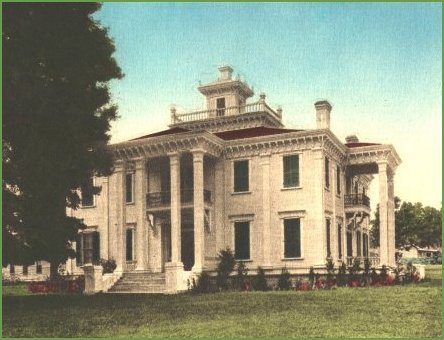|
Greenwood Le Flore, a wealthy planter of French and Choctaw ancestry, is known as "The last chief of the Choctaws East of the Mississippi", who negotiated the Treaty of Dancing Rabbit Creek, ceding the Choctaw lands to the United States. Malmaison ("House of Sorrow")
The beautiful old home of the last and most powerful Chief of the Choctaws, Greenwood Le Flore, is in Carroll County, Mississippi, nine miles east of the town of Greenwood, which was named in honor of the Chief. It was Le Flore's dream home, built when he retired from public life in 1854. Up to this time, he had been living about eleven miles from Greenwood in a log house built in 1835. The name, Malmaison, was chosen by Le Flore because of its association with Josephine, the Empress of France. A more picturesque location for a home could scarcely be found. An immense hill rises gradually from a lovely valley. About two-thirds of the way to the top it resolves into a broad plateau; upon this plateau stands Malmaison, the home of four generations of Le Flores.
The building is colonial in architecture, consisting of two halls crossing in the center of the building, four large rooms on each side, and an “L” of an equal number of rooms. It is two stories, surmounted with an observatory from which the country for miles can be seen. Towards the north the hill slopes upward and away, covered with rich grass and crowned with forest trees of giant size, interspersed with enough of pine and cedar to keep the background always green, thus presenting a scene of perpetual spring. This home was built in 1854, a successor to the first one, which was built in 1835, about one hundred yards east of the present site.
The furnishings of this stately mansion are in perfect accord with the building. The parlor is elegantly furnished; all the furniture was imported from Paris; the chairs, sofas, and divans are of French hickory overlaid with gold and upholstered with crimson silk damask; the long damask curtains are of the same rich color; the tables and etagere are of ebony inlaid with pearl of every hue. The carpet is a seamless tapestry of roses on a cream ground. The walls of this room are decorated with handsome paintings of Swiss and French scenes, and three immense mirrors in frames of gold. The mantle supports a clock of ebony and gold, representing a Crusader on horseback riding over the field of battle. The workmanship of this clock is exquisite and must be seen to be appreciated; also, on the mantle are two candelabra representing the figure of a knight holding a cluster of the golden lilies of France. The window shades are hand-painted pictures of four famous French palaces: Versailles, Fontainbleau, St. Cloud and Malmaison.
In all the rooms of the house the arrangement of furniture and bric-a-brac reveals the artistic taste and deft fingers of the lovely mistress of the home, Mrs. W. L. Ray, the granddaughter of Col. Le Flore. In the library are hung the portraits of Col. and Mrs. be Flore and their daughter, Mrs. Harris. That of the Chief is an excellent piece of workmanship and is said to be a perfect likeness. Beneath his portrait hang the sword and handsomely embroidered belt presented by the President of the United States, when Le Flore was made chief of the Choctaws; there is also a silver medal four inches in diameter given by Thomas Jefferson to a former chief and presented to be Flore when he was made chief. This medal was a symbol of peace between the Indians and the United States. On one side of the medal is depicted the pipe of peace across the tomahawk; beneath these are clasped hands denoting brotherly love. The other side bears the words, “peace and prosperity,” the name of the President and the date, 1802. A heavy silver-mounted sword-cane hangs near. On a table in the center of the library are several large volumes containing sketches of all the famous Indian tribes of North America, showing excellent likenesses and biographical sketches of their most noted chiefs. The dining room shows the same elegant taste that is seen throughout the home; handsome sideboards and china cabinets, laden with priceless china, cut-glass, and silver.
The lawn is quite extensive, covered with a heavy sward of Bermuda grass, shaded by magnificent forest trees; the gardens are noted for the wealth of bloom through the summer and autumn. This is one of the few old Southern homes still in the family of the builder and kept in the old-time style.
Malmaison was destroyed by fire in the early 1940s, the fire taking with it many beautiful and historical items, among which was one of only three original copies of the Treaty of Dancing Rabbit Creek. All that remains of the beautiful mansion, Malmaison, is a few chimneys and columns and the foundation on which it was built.

|


